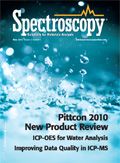The Sharper Teeth of the FDA
When long-time Spectroscopy columnist and industry expert Bob McDowall wrote in the November 2009 issue of Spectroscopy, "The new FDA Commissioner wants a strong FDA and is backing her words with action," he had no idea how right he was ("The Tiger Has Sharp New Teeth," Spectroscopy 24[11], 23–29, 2009). Here we are just five months later, and the internet, cable news networks, and radio talk shows are all abuzz with the latest initiative put in place by the U.S. FDA and its commissioner, Dr. Margaret Hamburg, to limit the amount of sodium Americans consume.
When long-time Spectroscopy columnist and industry expert Bob McDowall wrote in the November 2009 issue of Spectroscopy, "The new FDA Commissioner wants a strong FDA and is backing her words with action," he had no idea how right he was ("The Tiger Has Sharp New Teeth," Spectroscopy 24[11], 23–29, 2009). Here we are just five months later, and the internet, cable news networks, and radio talk shows are all abuzz with the latest initiative put in place by the U.S. FDA and its commissioner, Dr. Margaret Hamburg, to limit the amount of sodium Americans consume.

David Walsh
According to The Washington Post (4/20/10), "The effort would eventually lead to the first legal limits on the amount of salt allowed in processed foods," and would also lead to an unprecedented show of power on the part of not only the FDA, but the federal government in general. And while the left may cheer such a move as protecting public health and libertarians and the right may express shock at such a chilling invasion of personal freedoms, one is left to wonder what the implications of such a posture on the part of the FDA may be for the materials analysis community.
At the very least, it seems to indicate that regulations such as the postinspection response program described by McDowall (initiated on September 15, 2009) will be the norm rather than the exception. And new requirements such as complete responses to 483 observations within 15 working days could be a harbinger of further regulations to come for laboratories in the U.S., rather than a one-time move.
It will be interesting to see how this initiative plays out in the realm of public opinion, where the FDA will be either emboldened to pass further regulations and restrictions (sharpening the tiger's teeth further) or chastened by public outcry. One thing is certain, we will all be hearing more on this issue in the weeks and months to come.

David Walsh
Editor-in-Chief

Best of the Week: AI and IoT for Pollution Monitoring, High Speed Laser MS
April 25th 2025Top articles published this week include a preview of our upcoming content series for National Space Day, a news story about air quality monitoring, and an announcement from Metrohm about their new Midwest office.
LIBS Illuminates the Hidden Health Risks of Indoor Welding and Soldering
April 23rd 2025A new dual-spectroscopy approach reveals real-time pollution threats in indoor workspaces. Chinese researchers have pioneered the use of laser-induced breakdown spectroscopy (LIBS) and aerosol mass spectrometry to uncover and monitor harmful heavy metal and dust emissions from soldering and welding in real-time. These complementary tools offer a fast, accurate means to evaluate air quality threats in industrial and indoor environments—where people spend most of their time.
Best of the Week: AI and IoT for Pollution Monitoring, High Speed Laser MS
April 25th 2025Top articles published this week include a preview of our upcoming content series for National Space Day, a news story about air quality monitoring, and an announcement from Metrohm about their new Midwest office.
LIBS Illuminates the Hidden Health Risks of Indoor Welding and Soldering
April 23rd 2025A new dual-spectroscopy approach reveals real-time pollution threats in indoor workspaces. Chinese researchers have pioneered the use of laser-induced breakdown spectroscopy (LIBS) and aerosol mass spectrometry to uncover and monitor harmful heavy metal and dust emissions from soldering and welding in real-time. These complementary tools offer a fast, accurate means to evaluate air quality threats in industrial and indoor environments—where people spend most of their time.
2 Commerce Drive
Cranbury, NJ 08512
All rights reserved.